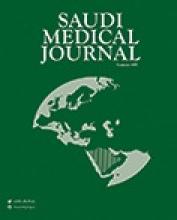Abstract
OBJECTIVES: To evaluate the outcome of part-time occlusion therapy with or without near activities in monocular amblyopic patients.
METHODS: One hundred and thirty patients who prescribed daily occlusion therapy (part-time occlusion) were followed-up for a 12-week period. The study was carried out in the Pediatric Ophthalmology and Orthoptics Clinics of King Abdul-Aziz University Hospital, Riyadh, Saudi Arabia for the period from January to November 2010. Sixty-five patients were recommended to undertake the 3 hours of near visual activities (such as reading a book during patching) while the other 65 patients were not advised to do any near activity. Main outcome measures were best corrected visual acuity (VA) for both groups and line improvement.
RESULTS: The total line of VA improved from baseline by an average of 6.7±2.37 line log MAR (logarithm of the minimum angle of resolution) units in the group of patching with near activities and by an average of 5.3± 2.04 line log MAR units in the group of patching without near activities. All type of amblyopia (strabismic, anisometropic, and mixed types of amblyopia) improved significantly after patching with near activities. Both moderate and severe amblyopia improved significantly in the group of near activities compared with the group without near activities.
CONCLUSIONS: Performing near activities while patching in the treatment of anisometropic, stabismic, or combined amblyopia improves the VA outcome more than patching alone.
- Copyright: © Saudi Medical Journal
This is an open-access article distributed under the terms of the Creative Commons Attribution-Noncommercial License (CC BY-NC), which permits unrestricted use, distribution, and reproduction in any medium, provided the original work is properly cited.






